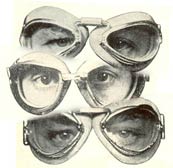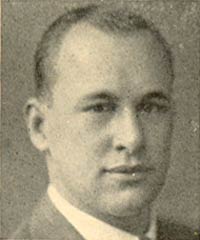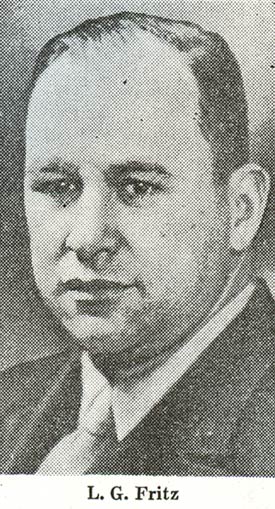Lawrence G. Fritz was born at Marine City, MI on August 7,
1896. He graduated college with a degree in marine engineering.
He was married twice (first wife deceased) and had two
children. He held Transport Pilot license No. 337. He had
a long and broad career in aviation, participating in military,
barnstorming, commercial and civil flying.
He died November 4, 1970 in San Francisco after suffering a
heart attack at his home in Saratoga, CA.
The Blue Book of Aviation (cited, left sidebar), 1932, cites him as, “Known
widely as a pioneer scheduled air transport pilot, …
first engaged in aviation when he joined the U.S. Army Signal
Corps, Aviation Section, in December of 1917. He went overseas
in 1918 as a member of the 282nd Aero Squadron, A.E.F., and
was stationed in England for the duration of the war, attached
to the Royal Air Force.
“Following his return to the United States, he was
a marine engineer in civil life for a short time. In 1921,
he re-entered the air service at Brooks Field, Tex. Following
his graduation in advanced flying at Kelly Field, Texas, he
continued with the U.S. Army Air Service until 1924.
“His first venture in commercial aviation was in 1924
when he engaged in barnstorming. The next year he was pilot
for the Stout Metal Aircraft Corpn., and later flew for the
Ford Motor Company’s air line.
AIRMAIL
On February 15, 1926 Captain Fritz and Captains Ross Kirkpatrick
and Dean Burford (who signed the Register three times during
1928-29), started the service over the newly established Ford
company routes. Fritz was the first to depart flying one of
the Liberty-powered 2-AT Air Transports east toward Cleveland,
Ohio. Then, Kirkpatrick departed from the Ford airport in
the second 2-AT and headed toward Chicago. Meanwhile, Burford
was taking off at the same time from Chicago's municipal airfield
and heading toward Detroit.
A fleet of six Ford single-engine air transports (the
famous 2-AT series) flew over 1,000 trips between Detroit-Chicago-Cleveland
during the first year of operations of the Ford Air Transport
Service. Most of these planes were later sold to Florida Airways,
a predecessor company of today's Eastern Airlines.
PASSENGERS
From 1927 to 1929, he
was chief pilot for the Maddux Air Lines, Los Angeles, Calif.,
and was vice-president in charge of operations for the Safeway
Air Lines, 1929-31.
“During his civil aviation career, he was pilot of
the plane carrying the first load of contract air mail for
the United States Post Office Dept., in Feb. 1926, on the
Ford airways; he piloted the first tri-motored plane across
the continent to Los Angeles, and he made the first successful
landing and take-off in a tri-motor (J-5 Ford) at Truckee,
Calif., in the high Sierras. This feat, accomplished for the
Fox Film Corpn., was effected at an altitude of 7,000 feet,
in a clearing of 1,500 feet.” Photo, above, is
from the Blue Book.
He signed the Davis-Monthan Register 14 times
between 1927 and 1930. He carried multiple passengers on the
first 12 of those flights, as he was then chief pilot with
Maddux Air Lines (see above). Among the Register aircraft he flew to Tucson are the Lockheed Vega NC7044, Ford trimotors NC428H, NC4532, NC5577, NC7117, NC7118, NC7582, and NC9639, and Northrop Alpha NC933Y.
L.G. Fritz Posed With Fokker F-32, Date Unknown (Source: Underwood)
 |
At left, a photograph of Fritz standing in front of the port engine nacelle of a Fokker F-32. This photo is shared with us by friend of dmairfield.org, John Underwood. There is a photograph of an F-32 at aerofiles.com. It was a large and impressive aircraft for the time. Please direct your browser to NC334N on our Peterson Field Web site.
This is a four-engined aircraft, two engines per nacelle. Note the twin-bladed propeller and cylinder arrangement of the pusher engine behind Fritz' left shoulder. The front engine, over his right shoulder, has a three-bladed propeller.
WWII MILITARY RESPONSIBILITIES
During WWII, Fritz was a Brigadier General in the Air Transport
Command's North Atlantic division. Photo, right, is from an
unidentified newspaper, dated October 4, 1945.
Time Magazine (December 4, 1944) had this to say about his
pioneering efforts in North Atlantic transport during wartime:
“The man who runs this airway is tough, gruff Brigadier
General Lawrence G. Fritz, onetime operations vice president
for the T.W.A. When he was A.T.C.'s operations chief in Washington,
he used to assert: "The North Atlantic can be flown both
east and west on regular schedule in winter as well as summer."
"One day in the fall of 1942 he stepped into a B24, flew
it out into the North Atlantic seeking the worst weather "front"
that he could find. His plane picked up a load of ice, lost
flying speed and dropped into a spin. Fritz, a veteran airline
pilot, straightened her out just a few hundred feet from
the water. He came back still convinced that he was right.
He was handed the job of proving his point as C.O. of the
North Atlantic Division.
"In the winter of 1943-44 the division flew more traffic
over the Atlantic than in the whole summer of 1942. Traffic
is up to more than 40 crossings a day. Last month more passengers,
cargo and mail moved over the Army's North Atlantic run
than during any month last summer (except during the period
immediately before and after the invasion).
"Larry Fritz was too old and too precise a hand to try to
beat the North Atlantic by pounding across by guess and
by God.
Larry Fritz, Date Unknown
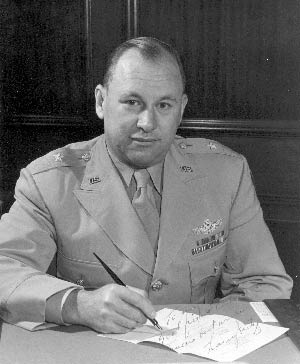 |
"The weather hazard was beaten by establishing a huge network
with alternate fields for emergencies. Weather stations
were set up—53 of them—and radio communications
were installed to get their observations to the forecasters.
The network is operated by officers who learned their job
in the operations end of the U.S. airlines. The stations
are manned by thousands of G.I.s.”
Photograph, left, of Brigadier General Fritz. The image is inscribed at lower right to fellow Register pilot Robert Love. It says, "To My Good Friend, Bob Love. Sincere Best Wishes. Larry Fritz."
He was a pilot for TWA. Photograph, below right, shows Fritz on the gangway of a TWA liner, date unknown. The photo is shared by John Underwood.
L.G. Fritz (R) With TWA Staff and Airplane, Date & Location Unknown (Source: Underwood)
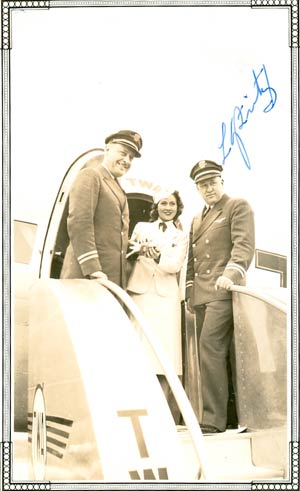 |
---o0o---
Dossier 2.1.
THIS PAGE UPLOADED: 12/23/05 REVISED: 02/13/08, 06/26/09, 03/05/10
|

